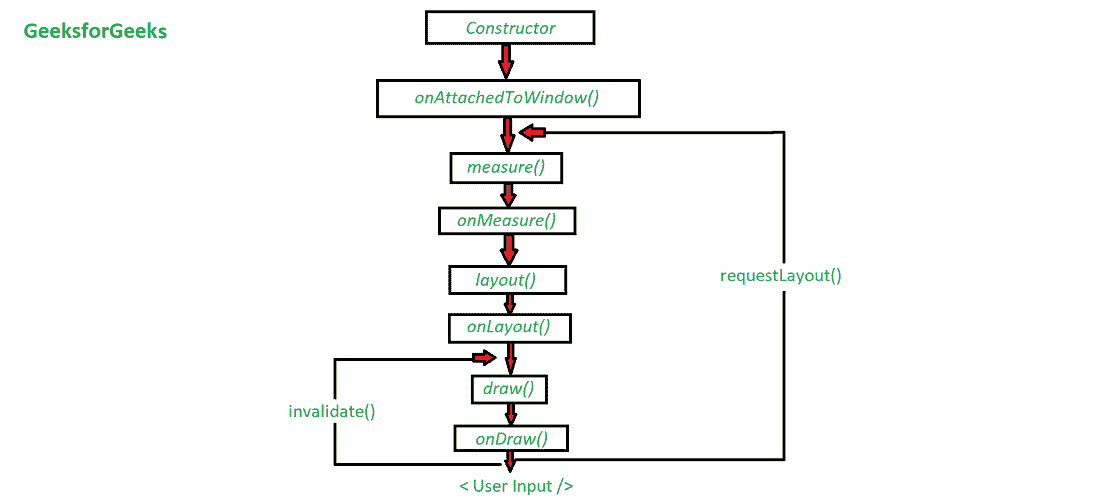如何用 Kotlin 在安卓中创建自己的自定义视图?
原文:https://www . geeksforgeeks . org/如何使用 kotlin 在安卓中创建自己的自定义视图/
在本文中,我们将讨论如何在 Android 中一步步创建自己的自定义视图。我们都知道一开始安卓平台给我们提供了一些基本的视图比如——TextView、ImageView、EditText、Button、ImageButton、RadioButton 等。但是,有时我们需要一种全新的视图,我们预先构建的布局和小部件无法满足我们的需求。所以,让我们深入研究一下。
安卓中什么是自定义视图?
首先,安卓中定制视图的概念无非是拥有我们自己的定制视图模型,而不是预先构建的视图模型。我们如何做到这一点?只需将不同类型的预构建视图组合在一起,然后将组合视图作为单个视图使用。
为什么我们的应用程序中甚至需要它们?
我们都知道一开始安卓平台给我们提供了一些基本的视图比如–TextView、 ImageView 、 EditText 、 Button 、 ImageButton 、 RadioButton 等。但是,有时我们需要一种更具交互性和复杂性的视图,在这种视图中,我们预先构建的布局和小部件无法满足我们的需求。在那里,自定义视图进入画面。现在安卓系统中的定制视图都是开发者为了达到目的而完全定制的。虽然定制视图并不是到处都需要。但是,在复杂性更高的更高开发级别,我们需要它们。
我们将如何创建自己的自定义视图?
每当我们要为我们的应用程序创建自定义视图时,我们都需要考虑一些项目。介绍一下安卓系统中视图的生命周期。

现在,有三个基本方法很重要。
- onMeasure()
- only layout()
- onDraw()
这 3 个方法将在相应的 Java/Kotlin 类中被覆盖。
1.测量()方法
如方法名称所示,它用于测量目的。基本上,我们可以控制自定义视图的宽度和高度。
- 如果没有被覆盖:视图的大小将是“match_parent”或“wrap_content”。
- 如果被覆盖:在覆盖这个方法时,我们对自定义视图的大小有更多的控制。不要叫方法 【超级测量()】 。相反,我们将调用方法 “设置测量尺寸(宽度,高度)”。
覆盖测量():
当这个方法被调用时,我们得到 【宽度测量规格】 & 【高度测量规格】 作为参数。大小模式是由父代为其子代视图设置的约束。下面列出了可用的 3 种模式。
- unspecify:没有给定约束,所以可以是它想要的任何大小。
- 精确:为子视图确定精确的大小。
- AT_MOST: Child 可以任意大到指定的大小。
示例:
我的锅
override fun onMeasure(widthMeasureSpec: Int, heightMeasureSpec: Int) {
// requested width and mode
val reqWidth = MeasureSpec.getSize(widthMeasureSpec)
val reqWidthMode = MeasureSpec.getMode(widthMeasureSpec)
// requested height and mode
val reqHeight = MeasureSpec.getSize(heightMeasureSpec)
val reqHeightMode = MeasureSpec.getMode(heightMeasureSpec)
// your choice
val desiredWidth: Int = // TODO("Define your desired width")
val desiredHeight: Int = // TODO("Define your desired height")
val width = when (requestedWidthMode) {
MeasureSpec.EXACTLY -> reqWidth
MeasureSpec.UNSPECIFIED -> desiredWidth
else -> Math.min(reqWidth, desiredWidth) // AT_MOST condition
}
val height = when (requestedHeightMode) {
MeasureSpec.EXACTLY -> reqHeight
MeasureSpec.UNSPECIFIED -> desiredHeight
else -> Math.min(reqHeight, desiredHeight) // AT_MOST condition
}
// set the width and the height of the view
setMeasuredDimension(width, height)
}
2.onLayout()方法
父视图使用此方法通知我们的自定义视图它的位置。人们应该用它来计算他们的绘图宽度和高度。点记无论在发生什么事情 onMeasure()** 都会影响仓位,从母公司得到。建议在继续绘制视图之前,应始终计算此处的绘图尺寸。
3.onDraw()方法
所有的绘图都发生在这个部分。这一点也不难,因为你得到了一个画布对象的实例,你可以自由地画任何你想要的东西。
覆盖 onDraw() :
首先为了简单起见用【getWidth()’&【getHeight()’方法得到画布对象的宽度和高度。
示例:
我的锅
protected fun onDraw(canvas:Canvas) {
// Grab canvas dimensions.
val canvasWidth = canvas.getWidth()
val canvasHeight = canvas.getHeight()
// Calculate horizontal center.
val centerX = canvasWidth * 0.5f
// Draw the background.
backgroundRect.set(0f, 0f, canvasWidth, canvasHeight)
canvas.drawRoundRect(backgroundRect, cornerRadius, cornerRadius, backgroundPaint)
// Draw baseline.
val baselineY = Math.round(canvasHeight * 0.6f).toFloat()
canvas.drawLine(0, baselineY, canvasWidth, baselineY, linePaint)
// Draw text.
// Measure the width of text to display.
val textWidth = numberPaint.measureText(displayedCount)
// Figure out an x-coordinate that will center the text in the canvas.
val textX = Math.round(centerX - textWidth * 0.5f).toFloat()
// Draw.
canvas.drawText(displayedCount, textX, baselineY, numberPaint)
}
